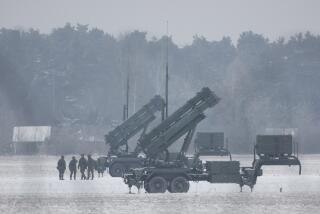The Price of Peace
- Share via
The U.S. nuclear weapons program has been central to American national security and to the nation’s “victory” in the Cold War, yet in some ways, it has always been a mystery to U.S. policymakers.
Because of the complexity and secrecy surrounding the nuclear arsenal, neither the military nor its congressional overseers ever added up the full cost of the program, which involves the military services and a variety of civilian agencies.
For the record:
12:00 a.m. April 22, 1998 For the Record
Los Angeles Times Wednesday April 22, 1998 Home Edition Part A Page 3 Metro Desk 2 inches; 69 words Type of Material: Correction
Nuclear costs--A pie chart published in Tuesday’s Times misrepresented elements of federal spending on nuclear weapons. The largest wedge in the chart, representing $24.8 billion, goes for strategic nuclear forces, the costs of tactical (battlefield) forces, maintenance of the nuclear stockpile and smaller programs. An accompanying graph on the nuclear stockpile over the past 50 years misidentified the source of the information. It came from the Natural Resources Defense Council.
In a four-year study of costs that is the most systematic yet, Brookings Institution researchers have calculated in a new book that the nation spends $35.1 billion a year to maintain the nuclear effort and to clean up its human and environmental aftereffects.
Although costs have declined 40% since the Soviet Union dissolved, they still represent about 14% of the defense budget. That’s far more than the amounts spent on a number of areas: Environmental protection; justice, including federal courts and prisons; and foreign affairs.
The Brookings book, “Atomic Audit: The Costs and Consequences of U.S. Nuclear Weapons Since 1940,” estimates that the program has cost about $4 trillion in constant 1996 dollars since the atom bomb was invented in the $21.6-billion “Manhattan Project” (’96 dollars). That’s almost three times the annual federal budget.
Stephen I. Schwartz, director of the research effort, said that without the statistical baseline provided by these numbers it is difficult to assess how well the program works, and whether, and where, it ought to be changed.
*
“How do you know your money is being well-spent?” Schwartz asks. “The underlying costs have never been well understood.”
*
The shortage of information is in part due to the secrecy shrouding the nuclear program. Pentagon policy even today forbids officials to confirm or deny the location of nuclear weapons, their number, destructive power, or other details.
Did the United States get good value for the $4 trillion it spent? Since nuclear weapons helped win the Cold War, many Americans would say yes.
Even so, there was vast waste, especially in the first two decades of the program.
The military spent $7 billion, for example, working on a nuclear-powered aircraft the Air Force hoped could fly almost indefinitely, but that turned out to be too heavy to be viable.
Another seven years and $50 million were spent on a plan for a spacecraft that was to be powered by ejecting and exploding nuclear bombs in its wake. The U.S. government usually took the view that the program was so urgent and vital to U.S. defense that keeping close tabs on cost was of secondary priority. But the book’s authors contend that if the nuclear program had had closer oversight and better numbers the United States might have foreseen problems and saved huge amounts of money.
The continuing environmental cleanup expected to cost hundreds of billions of dollars “might have been significantly cheaper if we had taken just a few more precautions earlier on,” said Steven M. Kosiak, a defense analyst and contributor to the book.
*
FEDERAL SPENDING (in billions)
Social Security: $381.5
Net interest on the national debt: $241.7
Income security: $239.4
National defense: $229.2
Medicare: $198.1
Health: $131.8
Education, training, employment & social services: $55.1
Transportation: $41.5
Veterans benefits & services: $41.1
Nuclear weapons and infrastructure: $35.1
Natural resources & environment: $23.8
Administration of justice: $22.3
General science, space & technology: $17.1
International affairs: $14.5
General government: $12.9
Community and regional development: $11.8
Agriculture: $10.6
Commerce and housing credit: $3.5
Energy: $0.4
*
Nuclear Breakdown (in billions)
Strategic nuclear forces: $24.8
Cold War cleanup: $5.9
Missile defenses and prevention: $4.4
*
Spending for U.S. Nuclear Weapons Research, Development, Testing and Production (in 1996 dollars)
(Please see newspaper for full graph information)
- Cold War average: $3.6 billion
- 1998: $3.9 billion (1996 dollars)
*
The U.S. Nuclear Stockpile
(Please see newspaper for full graph information)
- 1997: 8,650 Strategic weapons in stockpile
Note: National defense category has been adjusted to exclude nuclear weapons and infrastructure costs. Nuclear weapons costs are a combination of actual and estimated expenditures.
Sources: Brookings Institution, federal budget.
More to Read
Sign up for Essential California
The most important California stories and recommendations in your inbox every morning.
You may occasionally receive promotional content from the Los Angeles Times.













